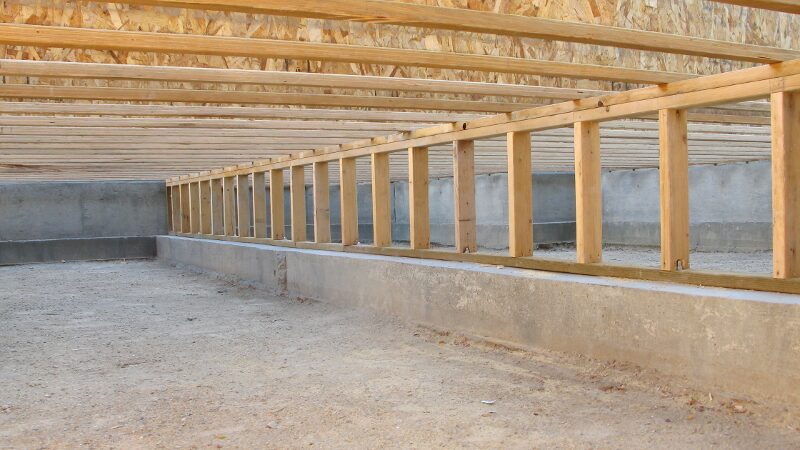Maybe the crawlspace isn’t the heart of your home. However, the crawlspace is one of the few elements that can reveal the health and durability of a Houston home. Simply put, a problem that affects your crawlspace may indicate specific foundation issues that could lead to significant damage throughout your home if left untreated. Thus, identifying crawlspace issues is a crucial part of preventative foundation maintenance.
Because the pier and beam foundation that forms the crawlspace underneath your Houston home might be affected by different issues that could lead to extensive damage throughout your entire house, here is a list of the most common problems you should look for when inspecting your crawlspace.
Cracks in Piers and/or Beams
While cracks in the piers and/or beams of a pier and beam foundation can occur due to different reasons, they typically develop when:
- The clay soil underneath a home expands and contracts repeatedly, according to the variation in its water content. In that case, the piers may start to move, crack, and even collapse, which may cause the beams to move and crack as well. All these problems will eventually weaken the entire structure.
- The ground underneath or around the crawlspace is affected by differential settlement and/or heaving.
- A home addition is built without considering whether the existing structural elements can withstand the new loads along with the resulting compressive, tensile, bending, and shear stresses.
In general, the load-bearing components of a pier and beam foundation that have sustained some damage need to be repaired or replaced with new elements in order to restore the structural integrity of the home. Depending on the underlying issue(s) identified, additional corrective measures, such as soil stabilization, might also be necessary to prevent the same or other problems from affecting the structure in the future.
Excess Moisture or Water Accumulating in the Crawlspace
Many people wrongly assume that excess moisture or water can only affect the pier and beam foundation components made of wood. In practice, however, concrete elements can also absorb a lot of moisture and water. This could lead to some serious harmful effects, which range from musty odors, mildew and mold growth, and pest infestations to unhealthy air inside the home and structural damage.
Excess moisture or water that accumulates in your crawlspace could be the result of poor drainage or a drainage system that’s no longer working properly, leaky water or sewer pipes, clogged gutters, and/or faulty downspouts. But irrespective of the underlying cause, excess moisture or water almost always has a negative effect on the structure of a pier and beam foundation and the home itself. Therefore, if you observe too much humidity, mold growth on different elements, or standing water in or near your crawlspace, don’t ignore the problem. Delaying repairs will only lead to undesirable consequences and higher repair bills.
Sagging and Uneven Floors
When inspecting your crawlspace, you may observe that certain areas of the floor above look uneven. When a pier and beam foundation is involved, a sagging floor could be the result of:
- expansive clay soil, which could cause one or more piers to shift or sink as a result of repeated expansion-contraction cycles;
- one or more piers that have already collapsed;
- unstable beams, which may shift over time;
- omissions or errors during the building process, such as placing out specific load-bearing elements (e.g., piers, beams, and/or joists) further than recommended or using undersized structural elements instead of the ones specified;
- concrete damage, wood rot, and/or pest infestations, which may result from water leakage
Replacing any damaged components with new ones and installing additional elements that will better support the structure can alleviate the aforementioned problems while improving the structural integrity of your Houston home.
Shim Failure
Shims are thin pieces of material often used to slightly adjust the height of piers or beams in homes that need leveling. However, when contractors use non-standard, inferior materials, such as plywood, or shims aren’t installed correctly, shim failure could occur. This basically means that the original problem, which was repaired by installing the shims in the first place, could reappear. In those instances, replacing any damaged shims with shims made of steel and installing them correctly will fix the issue.
While pier and beam foundations can be affected by many issues, the biggest advantage of living in a Houston home that sits on this type of foundation is that most repairs are easier and less expensive than slab foundation repairs. This is particularly true when problems are identified at an early stage, and the right professionals are hired for the job.
If you’ve noticed any issues affecting your crawlspace but you’re unsure of what they might indicate, call our office right away to benefit from a complimentary foundation inspection and estimate. Since time is of the essence when it comes to foundation repairs, making sure that any problems you observe are repaired as soon as possible is the only way to fix foundation damage without further complications.

